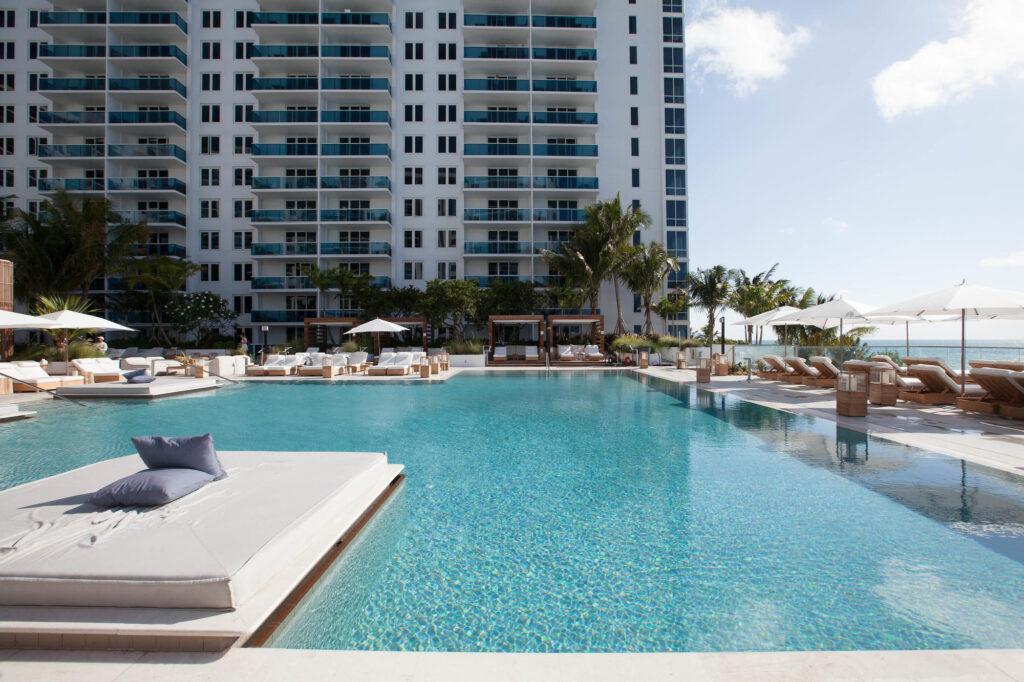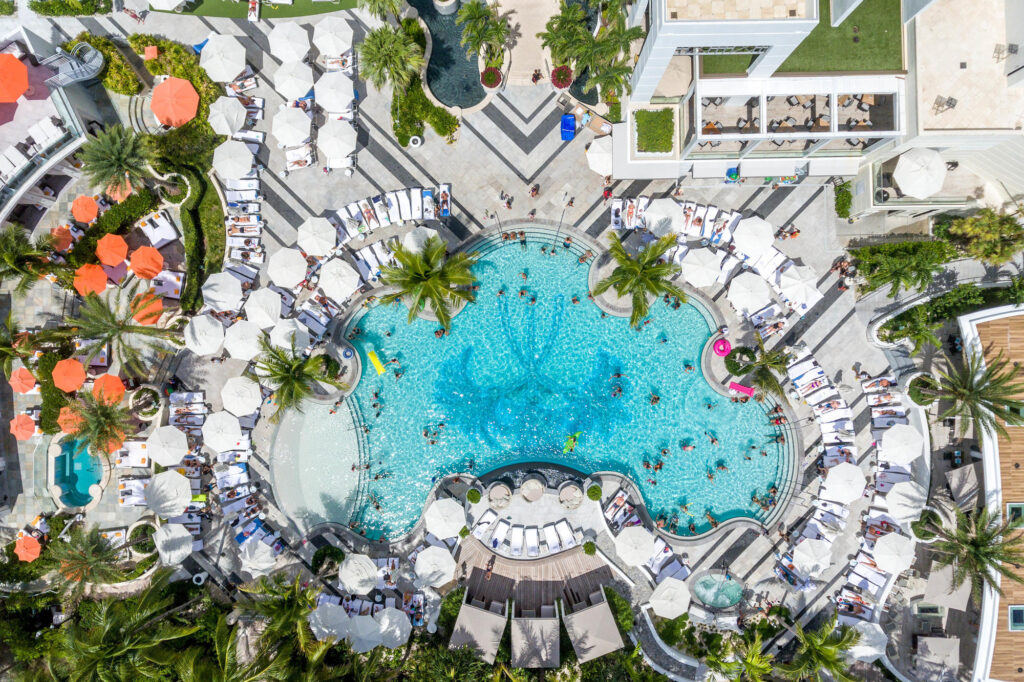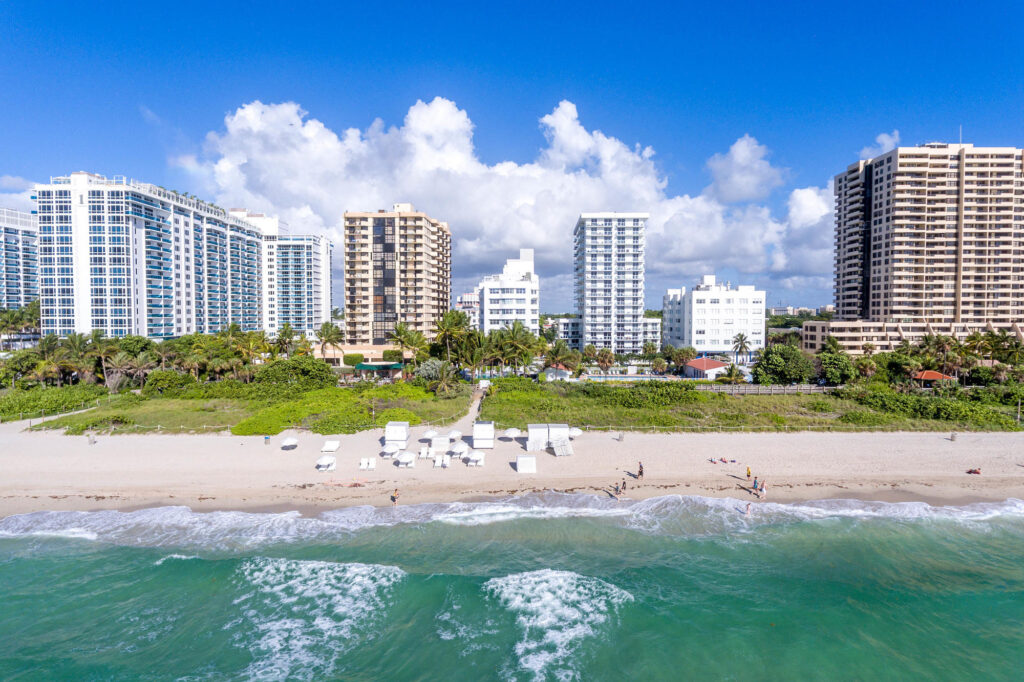12 Things Every Traveler Should Know Before Visiting Miami
Perched on Florida’s southern tip, Miami draws visitors from around the world with its blend of urban buzz and glamorous beach scene. However, visiting Miami is very different from visiting other popular Florida destinations. Why is that? Well, in terms of cultural diversity, vibrant nightlife, and overall bustle, Miami can feel light years away from hotspots like Orlando, St. Pete Beach, and the Florida Keys. To help first-time visitors make the most of their time by avoiding any faux pas (and hopefully saving some cash along the way), we’ve compiled a list of 12 key things every traveler should know before visiting Miami. Read on for tips on everything from the best time to go to Miami and its best beaches to where you should stay on your Miami vacation.
-
1. Miami is a late-night city that likes to party.
-
2. Pack more than beachwear for your Miami vacation.
-
3. The effects of climate change are already flooding Miami — and it's not going to get better.
-
4. Miami is home to huge Caribbean and Latin American communities.
-
5. The art scene is booming in Miami.
-
6. Miami Beach isn't the city's only beach (and isn't all there is to Miami).
-
7. Public transportation in Miami requires some know-how (and patience).
-
8. Parking in Miami is pricey, challenging to find, and strictly enforced.
-
9. When is high season in Miami? Book ahead if visiting from December through April.
-
10. The gay scene is out and proud in Miami.
-
11. Miami is expensive (but there are ways to save).
-
12. It can be fun to brush up on your Spanish in Miami.
-
Hotel Picks in Miami for Every Traveler
-
Miami Luxury Hotel Pick: 1 Hotel South Beach
-
Miami Family Hotel Pick: Loews Miami Beach Hotel
-
Miami Romantic Hotel Pick: COMO Metropolitan Miami Beach
-
Our Favorite Vacation Wear for Miami

New York isn’t the only U.S. city that never sleeps. Whether you’re just dining out or gearing up for Miami’s legendary club scene, you’ll want to consider pushing your plans back later than usual — or risk being the first to arrive. Leading clubs, such as Space and E11even are open around the clock, while another top choice, LIV, doesn’t open its doors until nearly midnight. You'll also want to keep in mind that headlining DJs usually don’t take the decks until as late in the night — we're talking between 2 and 3 AM in most instances. If you’re looking for something on the earlier side, head to Lagniappe, an open-air bar that puts on live music for a more traditionally primetime crowd. You'll also want to make note of the many seasonal parties that take up residence along Miami Beach, which can mean 24/7 beats for days at a time. These include March's Ultra Music Festival, May's Rolling Loud, and the week-long Miami Beach Pride that starts in late-March. This is to say nothing of the individual hotel parties that take place up and down the beach, as well as the events associated with major events like Art Basel and the Miami Food Festival.

This isn’t the Florida Keys or Daytona Beach, so don’t plan on sporting flip-flops and swimsuits anywhere other than the beach or hotel pool when you're in Miami. To be fair, even the pools can feel like fashion runways at some of the city's posh hotels. Many restaurants and bars enforce dress codes in Miami — including Miami Beach and South Beach — while clubs can be as selective, barring entry to sandal-wearing clientele. Miami is one of the United States’ most cosmopolitan cities, so dress to impress, or at least try not stand out for the wrong reasons. If you're after a more casual vibe, the beach towns up the coast makes a great alternative, or stick to the restaurants and bars tucked away on Miami's side streets rather than the dining scene along Collins Ave., Lincoln Road, and Ocean Drive.

Oh, Miami — so blessed and so cursed at the same time. While the city sits firmly in the hurricane zone and has been victim to several major storms in the past, the largest current threat is fair-weather flooding due to climate change. These floods are most often associated with king tides, which are excessively high tides caused by lunar and solar cycles. While these have been a normal occurrence since the beginning of time, rising sea levels fueled by climate change have cause these tides to become even more destructive in Miami. This is exacerbated by the porous stone that underlies much of the South Florida region, allowing water to rise from directly underneath this major urban area. King-tide flooding can happen regardless of weather — though it's worse during high tides and weather events that cause the sea near shorelines to swell. In other words: It can be perfectly sunny outside, but several streets will be filled with water and impassable. September through November — which coincide with the end of hurricane season and the king-tide cycles — are the worst time of year for this troubling phenomenon.

Cuban culture is incredibly prominent in Miami, and enjoying a fresh mojito while watching a live salsa performance are highly recommended experiences. The strong Cuban presence stems from the fact that more than 25% of Miami-Dade County residents are Cuban-born plus the many descendants of Cuban immigrants that have arrived over the past six decades. However, this still constitutes less than half of the city's foreign-born population. Miami is also home to significant Haitian, Bahamian, Venezuelan, and Colombian communities — to name just a few. Between restaurants, art galleries, and music venues, there are plenty of ways to dive deeper into these other cultures. For starters, head to Little Haiti for free concerts and art at the Little Haiti Cultural Complex. Be sure to stop for spicy seafood at laidback Chef Creole.

Miami may not have the largest collection of museums, but art permeates the city in numerous ways, from public art and cultural centers to galleries and major art fairs. The Wynwood neighborhood, located just north of Downtown Miami, is teeming with street art and murals. The movement began in 2009 with the open-air Wynwood Walls, which encompasses 18 walls of work created by international graffiti artists. Since then, street art has expanded throughout the neighborhood, with notable displays at Wynwood Brewing Company and along NW 2nd Avenue. Other street art hotspots include Calle Ocho in Little Havana and throughout Little Haiti. Since 2002, Art Basel has drawn renowned artists, collectors, and enthusiasts to Miami each December for a week’s worth of exhibitions. If you can’t make the event, fret not, as many of the participating galleries showcase outstanding works of art year-round. The sizable Rubell Family Collection exhibits a wealth of avant-garde works by art legends like Keith Haring and Andy Warhol. Free exhibits can be found at Locust Projects and Spinello Projects, while Yeleen Gallery in Little Haiti features works that highlight the neighborhood’s Caribbean roots.

Miami Beach — the famed stretch of sand that's lined by stunning art deco buildings — is a must for a proper Miami visit. In fact, many people consider Miami Beach and South Beach to be Miami itself. That's problematic for a ton of reasons. However, one of the biggest sins among them is limiting yourself when it comes to beaches. Many first-time visitors make the mistake of not venturing farther afield to take full advantage of the extensive network of beaches found in the Miami region. Below South Beach, Virginia Key boasts sandy shorelines without the crowds. Admission to Virginia Key Beach Park costs $8 per vehicle on the weekend, but the extra space and kayaking through wetlands are worth the added cost. Heading farther out on the causeway, Crandon Park is a family-friendly beach on Key Biscayne with water-sports and cabana rentals. Just above Miami Beach, Haulover Beach is divided between nude sunbathing in the north and a dog-friendly portion in the south.

Miami’s public transportation system is the largest in Florida, and includes buses, trolleys, Metromover, and Metrorail. Both the Miami Trolley and Metromover are free to use and aid in visiting the mainland portions of Miami, such as Little Havana, Wynwood, and Brickell City Centre. That being said, both are limited in geographical scope and — notably — don't connect to Miami Beach or South Beach. The Metrorail connects with the Metromover at several stations, but requires a $2.25 fare. It’s an affordable option for traveling to the airport and the outlying neighborhood of Coconut Grove, but little else. It also doesn't connect with Miami Beach. The Metrobus is the most extensive public transit network in the city, but is impeded by the congested traffic that is pervasive throughout Miami’s streets. For traveling shorter distances, try Freebee – a free electric car service that can be accessed via the Freebee mobile app. While the service is free thanks to funding from car door advertisements, be sure to tip your driver a few bucks. If you're staying in Miami Beach and South Beach only, consider renting a bike, using your own two feet, or bank on relying on taxis. Bringing your own car? Get ready for epic parking headaches (more on that below).

As mentioned previously, Miami is somewhat notorious for its traffic. However, even unperturbed and seasoned city drivers should be aware of some Miami parking peculiarities before getting behind the wheel. In Miami Beach, street parking is the costliest option, running as high as $4 per hour in South Beach. Off-street lots cost comparatively less at $2 per hour, while parking garages are the best option for lengthier stays with day rates as low as $20. On the flipside, parking costs in downtown Miami neighborhoods operate in the reverse order. Hourly rates in parking garages run as high as $7 per hour, while a full-day can cost nearly $30. Furthermore, avoid parking in Miami Beach’s residential zones without a valid permit during restricted hours, which include the entire weekend as well as weekday evenings. These rules are strictly enforced and the authorities will not hesitate to tow your car away.

While Miami bustles throughout the year, the high season for tourism runs from December through mid-April, with notable peaks around the Art Basel festival in early December, between Christmas and New Year's Day, and during spring break. While prices do rise with demand, you can reduce the added expense by booking flights and hotels several months in advance if you want your visit to coincide with the city's best weather.

When it comes to gay life in Florida, Miami and Ft. Lauderdale (up the coast) take the cake. Miami serves as a major party destination for LGBTQ travelers, and has a handful of legendary gay clubs. Twist and Palace are the most famous of these venues, and each draw world-famous DJs and host excellent drag shows. You'll find plenty of smaller venues throughout town as well, some of which cater to a mixed gay-straight crowd. Hotels in Miami are almost all universally welcoming of LGBTQ travelers, and you'll see couples of all stripes holding hands in public. The city hosts several major gay events throughout the year as well, including the White Party and Miami Pride events.

There's no way around it: Miami is one of the priciest cities to visit in the United States. Given its legendary status as a mecca for parties, beaches, luxury services, amazing restaurants, art, and nightlife, the city has enough pull to make it a hotspot year round. While we've already told you that the winter months and early spring are high season — and thus mean paying a premium on everything from flights to hotels — there are ways to save. You'll find slightly cheaper hotel rates if you're willing to stay on the back side of Miami Beach, toward Biscayne Bay. From there, it's only a 15-minute walk to the beach, and you'll enjoy a quieter vibe. You'll also find meals for slightly less if you dine away from hotspots like Lincoln Road, Ocean Drive, and Collins Ave. Food and drink on the mainland are generally less expensive as well, and you'll likely get more for your money when it comes to hotels, too. However, you'll be paying to commute to the beach and nightlife of South Beach. If you're willing to visit when the weather is humid and hot, May can be a decent time of year as well, with rates that are lower than the winter and early spring months.

Miami’s mix of Latin American and Caribbean cultures means that Spanish is the first or second language for the majority of its residents. In fact, only about a quarter of Miami-Dade County speak only English. That being said, you aren't expected to be a Spanish master here. However, it can be fun to practice your Spanish while you're in town. If you're addressed in Spanish, certainly make a go at having a basic conversation. For Spanish newbies, using simple greetings like “cómo estás” (how are you) when appropriate will earn you some credibility. Even more skilled Spanish speakers may still find the more prevalent Cuban accent hard to decipher, so be patient and don’t hesitate to employ Spanglish in this multicultural city when necessary. It’s also worth building up your knowledge of food-related lingo to help navigate menus at hole-in-the-wall establishments and restaurants alike. That's particularly true at the old-school Cuban diners found throughout the city. To put your language skills to the test, try ordering a cafécito (Cuban espresso) in the Little Havana neighborhood.


It's no secret: We love the 1 Hotels brand. There's just something about how effortlessly they combine sustainability, luxury services and amenities, and boho style that makes them appealing no matter where you are in the world. Of course, their South Beach outpost has the added bonus of overlooking Miami's beautiful beach, and features one of the nicest pools in all of South Beach. It's also just a bit removed from the insanity of central South Beach and Collins Avenue, which makes it extra appealing for an exclusive luxury getaway.


One of the most popular hotels in South Florida, the Loews Miami Beach Hotel sits smack in the middle of the South Beach scene, making it easy to get practically anywhere in town. This iconic property is popular with groups of friends and couples — there's an adults-only pool for them — but also happens to be one of the best options for families with kids in Miami. There's a dedicated area for children on the beach, as well as an extensive kids' club that organizes tons of different programs for kids aged 4 to 12.


Situated at the more peaceful northern edge of South Beach, the COMO Metropolitan combines this brand's wellness ethos with just the right dash of Miami style. Rooms and suites are gorgeous, and many have stunning ocean and beach views. The spa is one of the best in the region, offering a variety of treatments, and on-site dining scores raves from previous guests. It's a chic, romantic retreat and its 74-room size means that it feels more intimate than some of the mega-hotels that line Miami's shores.